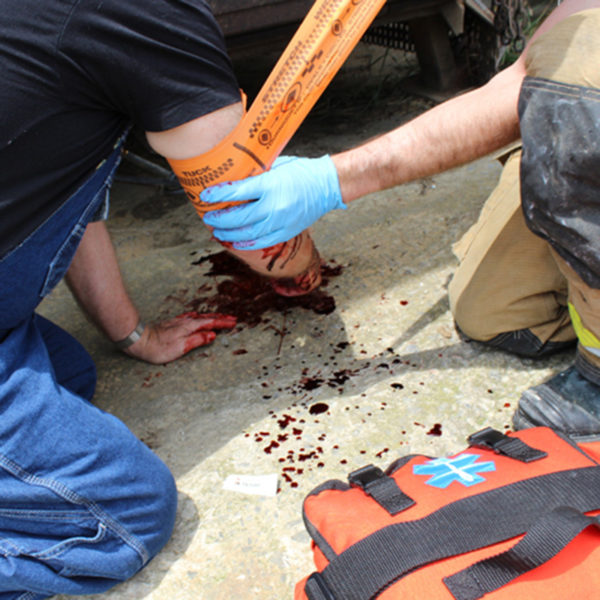By Thom Bolsch and Ron Mullins
We all expect that a Fire Truck, Ambulance or Law Enforcement Officer will be the first to the scene of an incident; that is why we refer to these professionals as “First Responders”!
But how did these “First Responders” know to respond?
Someone witnessed an incident and called “911”. Which means that witness, the first person on scene is “the” first responder. With that thought; how would you react if you were first on scene or witness to an accident? Would you know what to do?
Let’s get a little closer to home… What if: your child broke their arm, a co-worker choked on a piece of chicken at lunch, your daughter burned her hand trying to prepare dinner?
We are human, we are living in a real world and we are at risk – each and every one of us – each and every day. Can you handle the care necessary to deal with a broken bone, choking or a bad burn?
This month’s issue of Situation Report will begin a discussion on medical trauma. Please note, this article will not provide EMT training, but will offer some basics and hopefully ignite a desire to learn how to help your family, your friends and your co-workers in the event of a medical emergency.
We will begin the dialogue as a witness and walk through a basic triage of care…
Step 1: Assess/Evaluate the area for hazards; you don’t want to be a second victim.
Step 2: Call for help. Call 911 if you have access to a phone or have a passerby call.
Step 3: Care for the injured person.
In caring for the injured person; we want to check for the following:
- Are they RESPONSIVE? Alert with eyes open and talking or passed out.
- Are they BREATHING?
- Is there a PULSE?
- Are they BLEEDING?
- Do they have any BROKEN BONES?
We now have enough information to begin administering first aid and provide the 911 operator information to be passed on to the Para-Medic. (You’ll want to provide the 911 operator the injured person’s name, age, sex and the type of injury. If you know, or can determine if there are known allergies, a medical history and/or medications; provide this information as well.)
Let’s break down “First Aid” into five sections: BREATHING, BLOOD, BONES, BURNS, and BRAIN.
We need oxygen to survive, but the body only has one track for collecting oxygen; and it’s the same track for food to get from the mouth to the stomach. It’s an efficient design, but sometimes that track get clogged with food (or some other small item for little kids) preventing oxygen from getting to the lungs. We have a BREATHING issue; or choking! Choking can be complicated; but basically, we want to force the diaphragm in and up to force air out of the lungs and into the throat to blow the restriction out of the mouth. For most people we’ll approach from behind, reach around the person grabbing your hands with your thumb turned facing you below the sternum – and jerk in and up. You may have to execute the maneuver a number of times to get the restriction dislodged. (Note: for pregnant women and a heavy person, get them to lay on the ground and compress the chest just as you would with CPR.)
For BLOOD, we’ll check for BLEEDING and a PULSE. You’ll apply pressure on the source of the BLEEDING and bandage that source. (Severe bleeding on an extremity may require a tourniquet.) No PULSE requires Chest Pressure Repeated (Hands ONLY CPR) – here, immediacy of action is critically important to saving a life. We are compressing the chest to manually operate the heart to keep blood flowing to the brain.
BROKEN limbs should be immobilized with a sling or a splint. DO NOT try to reset the bone, and apply an ice pack to help numb the pain. If the break is compound and the bone has broken the skin, you have to deal with bleeding and the break. Apply a bandage to the break to contain the bleeding.
A severe BURN (don’t concern yourself with the degree of the burn, the skin is burned) will require cool clean water to wash the area. DO NOT apply any creams or oils. Pull away clothing that can easily be removed, but if the clothing is stuck to the skin leave if for a medical professional. Wrap the burned area with wet cloth.
And finally, the BRAIN. Immediacy of action for a stroke is critical to the survival and quality of life of individual. Remember the acronym FAST to assess the onset of a stroke. F – is the FACE drooping, A – can the arms be raised level with the shoulders, S – is speech slurred or difficult and T – time is critical in getting medical attention.
At some point in your life you may be the first person to arrive or witness an incident that requires medical attention. While this can be a very stressful, simple actions can assure your safety and help with the medical care of the injured. We hope this little introduction sparks an interest to be better prepared and to learn more about responding to life’s situations.
It should be pointed out that stopping to render aid is covered under the Texas Good Samaritan Law. The law exists to protect citizens who render first aid, within their scope of knowledge and training from a civil suit.
Stay Alert, Stay Safe,
Editor’s Note: If interested in learning more about first aid and emergency medical care; the July Special Guest Instructor is Dr. James A. Rinkle and he will be presenting an advanced first aid class on Self-Aid/ Buddy-Aid for the Prepared Citizen on July 16th, 2017. Seats are limited, sign up today.
© Copyright 2017
All rights reserved by Saddle River Range


